
San Giorgio Maggiore (Basilica di San Giorgio Maggiore, Venetian name: San Zorzi Mazor) is the Basilica of St. George in Venice, which is part of the adjacent Benedictine monastery and an important landmark of Venice.
The basilica is made in the Renaissance style and has a high bell tower, which you can climb and from which you can enjoy beautiful panoramic views.
The basilica has the status of a "minor basilica" (basilica minore).
The name "Maggiore", that is, "Main", the basilica received in order to distinguish it from the island of San Giorgio in Alga.
The Basilica of San Giorgio Maggiore is located on the small island of the same name San Giorgio Maggiore. The island can be reached by vaporetto (river tram, shuttle boat, the main form of public transport in the island part of Venice); there is a route of line 2 from the Slavyanskaya embankment (Riva degli Schiavoni, Riva degli Schiavoni), which is located opposite the island, through the San Marco basin.

The first church dedicated to San Giorgio was built between the 8th and 9th centuries. In 982, the island was donated by the Doge Tribuno Memmo to the Benedictine monk, Blessed Giovanni Morosini, who founded the monastery of San Giorgio Maggiore.
Padua architect Andrea Palladio was invited first to build the refectory (1560-1563) of the monastery, and then to design a new church.
In 1566, the first stone of the church was laid. The facade of the church was built between 1597 and 1610 by the Italian architect Vincenzo Scamozzi, after the death of Andrea Palladio.
The current bell tower, 63 meters high, was designed by the Somask architect Benedetto Buratti and dates back to 1791. The bell tower, which existed before and was built in 1467, collapsed in 1774.
In March 1900, Pope Leo XIII elevated the church to the rank of a minor basilica.
Today, the Basilica of San Giorgio Maggiore is an undoubted decoration of Venice and one of its main attractions.
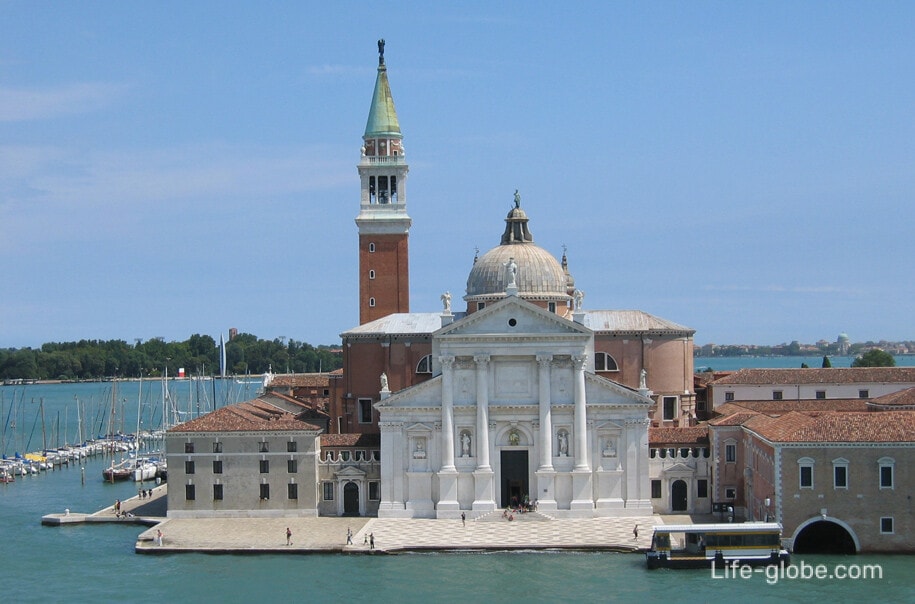

The main white marble facade of the church looks like a triumphal arch and has one main entrance and four huge monumental columns with pilasters mounted on high pedestals and topped with an entablature supporting a classical tympanum.
Statues of San Giorgio and Santo Stefano are placed in niches on the sides of the portal.
This magnificent facade contrasts sharply with the other brick-red walls of the basilica, and as if it covers them.
The grand staircase, built in 1643 under the direction of the Italian architect Baldassare Longena, leads to the main portal of the basilica. The area near the basilica (piazzale) is paved with multicolored, white and pink marble.
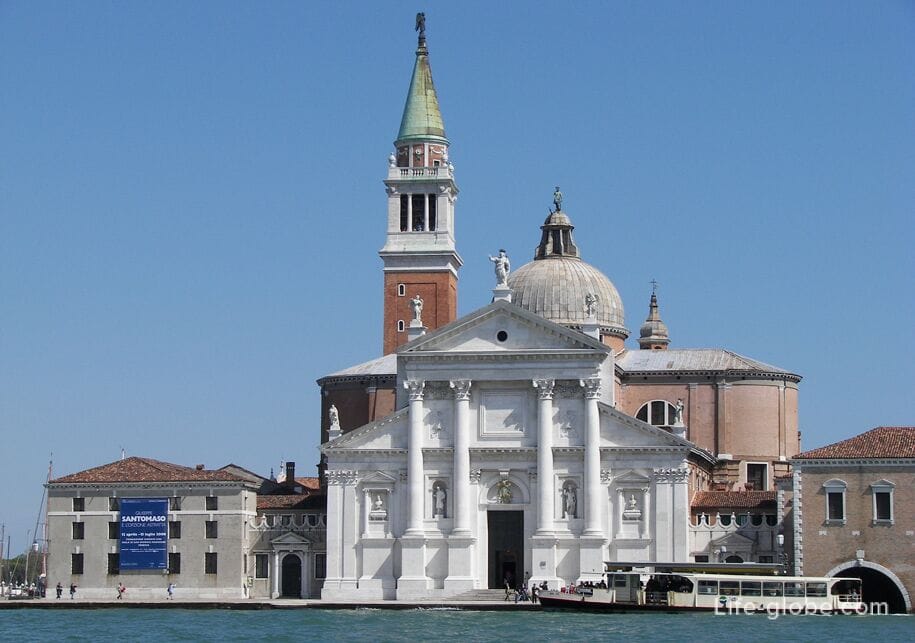
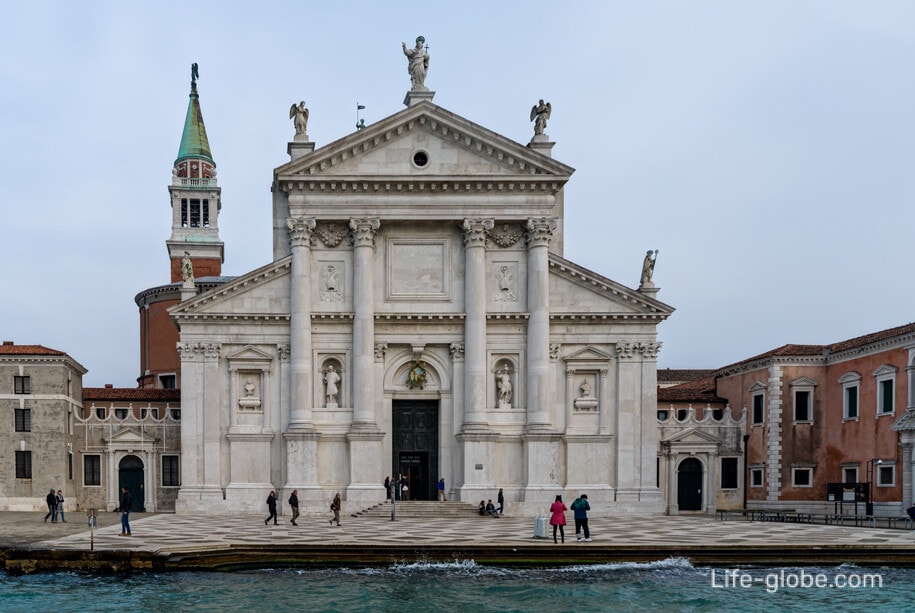
The dome stands out in the interior of the basilica, which divides the shrine into two almost equal parts.
Also, the internal division of the basilica has side aisles and a large wooden choir with a thin inlaid apse (placed as an extension of the presbytery).
Paintings of great interest have been preserved in the basilica. The most important of them are: "Madonna enthroned" and "Saints" by the Italian artist Sebastiano Ricci; "The Last Supper" and "The Gathering of Manna from Heaven" by Jacopo Tintoretto (in the presbytery); as well as other canvases by Italian artists Palma il Giovane, Domenico Tintoretto and Jacopo Bassano.


On the main altar you can see a large bronze sculpture by the Italian sculptor Gerolamo Campagna, designed by the Greek artist Antonio Vassilacchi, and known as "Aliense". This sculptural group represents four evangelists supporting Peace and God.
Above the wall that separates the presbytery from the choir is a valuable organ created in 1750 by Pietro Nakchini and restored in 1887 by Pietro Bazzani.
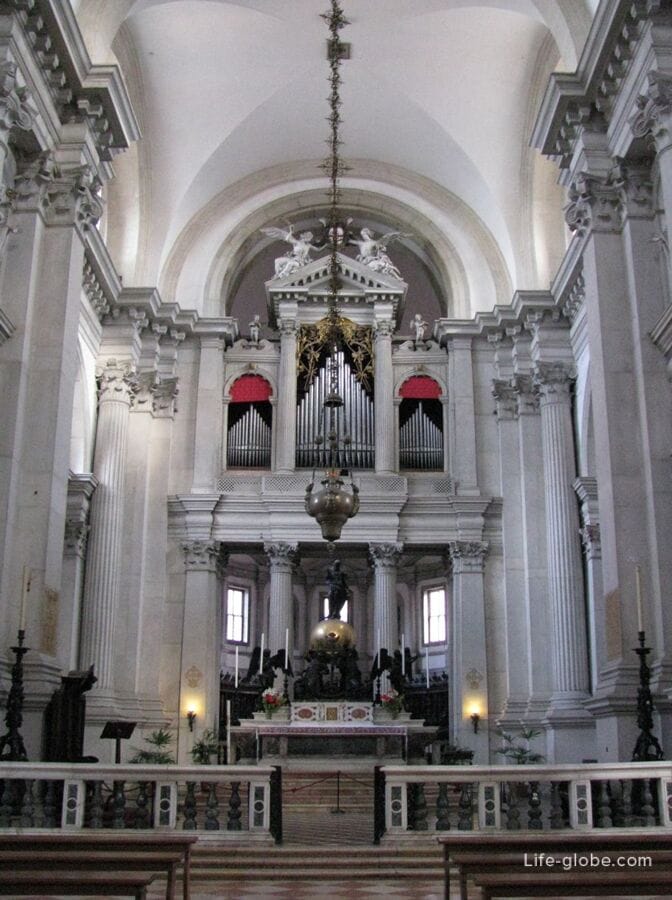

Also noteworthy in the basilica are the choirs with bas-reliefs by Albert Van der Brull.
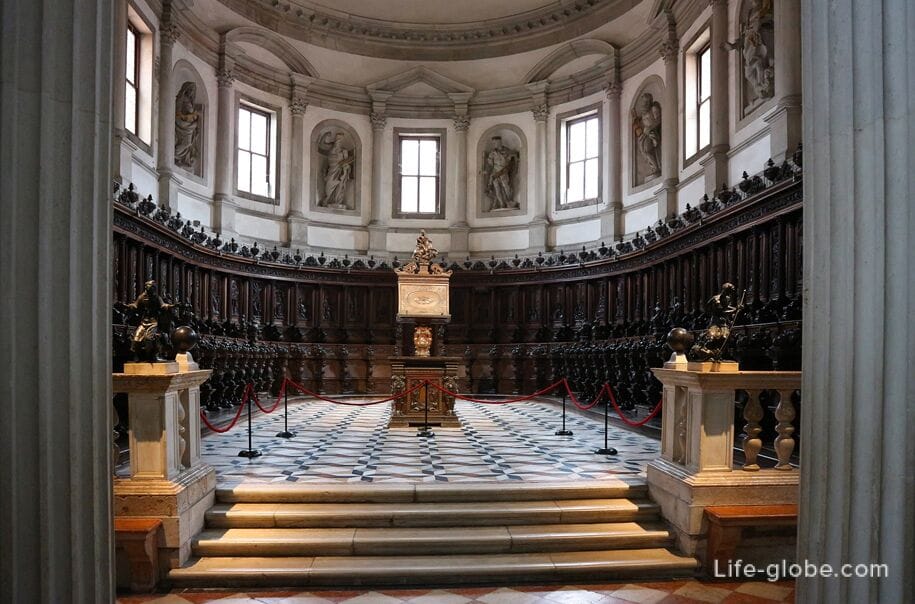
The bell tower (campanile) of the basilica with a square barrel, with a chamber made of Istrian stone and a conical spire, is the fourth tallest in Venice.
There is a public observation deck in the bell tower, where you can climb up and admire the beautiful panoramic views of the Venetian Lagoon, as well as the main historical islands of Venice.

The Basilica of San Giorgio Maggiore is part of the complex of the abbey monastery, in which the work of Palladian architecture is the chiostro (monastery courtyard), surrounded by galleries with "order arcades on columns".
Guided tours in Italian and English are conducted through the private spaces of the abbey, which can be requested at the bell tower lift counter.
During the tour, you can visit: the private chapel of the monastery, known as the chapel of the Dead, since it was used for the burial of deceased monks; the conclave hall, which was originally built as a night monastery choir - a place where, in accordance with Benedictine tradition, monks gathered for prayer after midnight; the ancient sacristy, built in the last 16 years the century and inside of which are remarkable clocks, sculptures and two canvases: "The Introduction of Jesus into the Temple" by Palm Jr. circa 1570 and "St. George killing the dragon", the date of execution of which is precisely known (1594) and it is attributed to the workshop of Domenico Tintoretto, the son of the great Jacopo Tintoretto.

Masses are regularly held in the Basilica of San Giorgio Maggiore.
Entrance to the basilica is free.
The ascent to the observation deck in the bell tower is paid; there are discounted tickets.
Guided tours of the monastery are paid, on request.
For exact information about the opening hours of the basilica, the cost of climbing to the observation deck, excursions, etc., we recommend checking on the abbey's website: abbaziasangiorgio.it.
The address of the Basilica of San Giorgio Maggiore: Isola di S.Giorgio Maggiore, 30124, Venezia.
Coordinates of the Basilica of San Giorgio Maggiore: 45°25'45.0"N 12°20'35.0"E (45.429167, 12.343056).
All accommodation facilities in Venice, including in the historical center of the city and more remotely from it, can be viewed and booked here